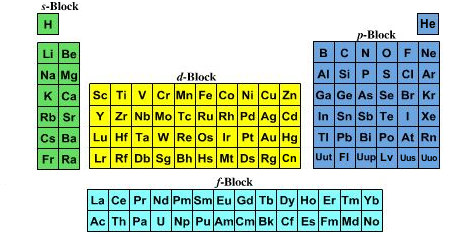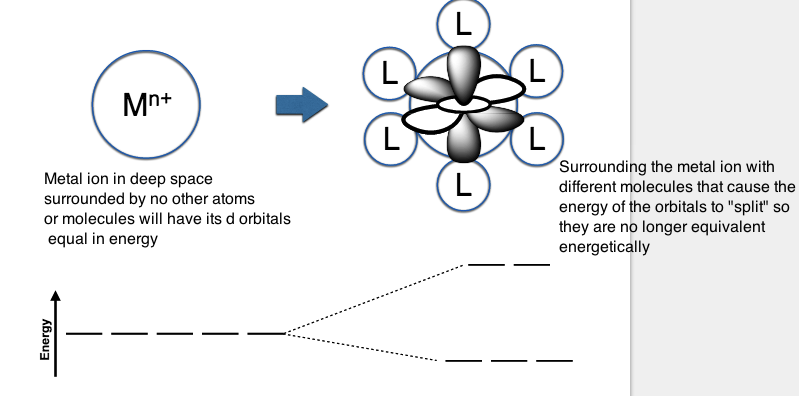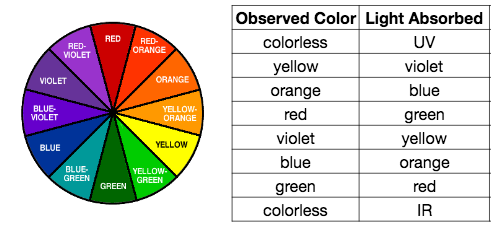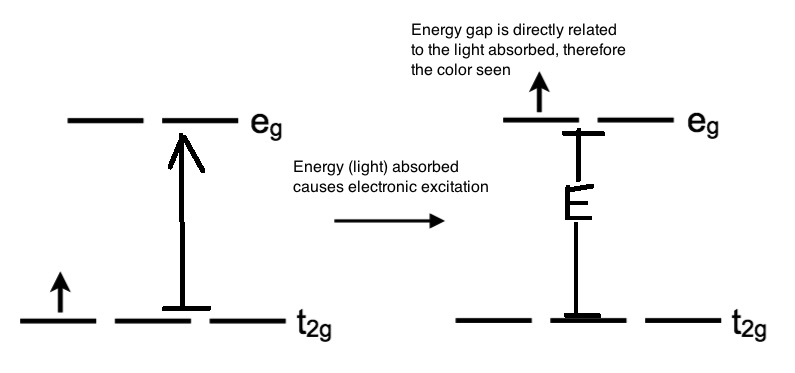When investigating the chemical composition of gemstones, a perplexing conundrum presents itself rather quickly. Some gemstones, despite having different colors, obtain their colors by having the same metals inside them. Ruby and emerald, for example, both are colored because of the chromium 3+ metal ions present in them. Yet ruby is red and emerald is green. Why, then, do gemstones have different colors at all?
To understand this phenomenon it is useful to know a bit of background on metals in general and why some metal compounds have different colors:
A metal is, chemically speaking, found in the “d block” of the periodic table (shown in yellow below).

Metals have five d orbitals. If a metal with those d-orbitals existed in deep space, surrounded by absolutely nothing else, those orbitals would all have the same energy. However, the d orbitals change in energy when the metal ions are put in different chemical environments (see below image).
If the orbitals contain unpaired electrons, those unpaired electrons can be excited into higher energy orbitals. This means that electrons in the lower energy orbitals can be excited with light into the higher energy orbitals.

The energy absorbed, and then subsequently released in these transitions gives these metals their “color”.

It is worth noting is that the color you SEE is different from the color absorbed by the compound.
The light you SEE = All colors – The light absorbed by a compound
(yes, I know this arithmetic is a bit odd, especially when working with our good old friend, ROY G. BIV)
For example, if a metal complex absorbs red light, all the light EXCEPT red light will be reflected back. Thus, you will SEE green light (because Green light = All light – Red light). You can use the color wheel to look for the CONJUGATE (or opposite) color of that absorbed.
As you change the number of electrons in a metal, you will change which electrons can be excited AND the way these electrons are “allowed” to be excited. Thus, the amount of energy inputed to a compound for this excitation changes and thus the color observed changes.

This is why Iron(2+) (6 valence electrons) and Iron(3+) (5 valence electrons) have different colors. The rusty red-colored iron is the iron 3+ ion, and the green colored iron is the iron 2+ ion.
So, as for the way all this information applies to gemstones, you basically have two options:
1) Same metals and number of electrons, different chemical environments
You can get different colored gemstones that have the EXACT SAME metals that each have the SAME amount of valence electrons in the d orbitals. However, their different colors are attributed to the fact that the metals are surrounded by a DIFFERENT crystal lattice structure, thus the metals are in a DIFFERENT chemical environment!
The differed chemical environment changes the gap in energy between the d-orbitals. Thus, the amount of energy absorbed by the metal to excite an electron into a higher energy orbital changes, and the energy released (in the form of light — colors!) is different.
Thus, the color you see is different because of these surrounding atoms, despite the EXACT SAME metals (and the same number of electrons) being present in both gemstones.
This is why ruby and emerald, although BOTH contain Chromium(3+) and and both have 3 d-electrons, are different colors. Ruby is surrounded by Aluminum oxide (Al2O3), and emerald is surrounded by the mineral beryl (Be3Al2(SiO3)6).
2) Same chemical environments, different metals
For the second option, you get different colors for gemstones with the SAME crystal structures, but the METALS, which will have different amounts of electrons, embedded in those crystal structures will be different.
For example, sapphire and ruby both have aluminum oxide embedded in their crystal lattices. So why do they have different colors? Because both have different metals embedded in those Al2O3 structures!
Ruby, as previously mentioned, has chromium(3+) ion in it, while sapphire has iron(3+) and titanium(3+) ions in it. Thus, the electrons causing the light energies to be emitted are different, so you see different colors from each gemstone.
So, next time your grandma asks you what your birthstone is (do people even care about birthstones anymore?) you can fully explain how gemstones even get their color!
And at the end of the day, even if you and your grandma don’t get all too excited about gemstone colors, let me tell you, electrons sure do. And I suppose that’s all that matters anyway.
(hahah oh man i’m so sorry).
By the way, the idea for this post came from a great new podcast called Holy F***ing Science (which I highly recommend!). In the first episode, The Bare Minerals, Please they discuss the colors of gemstones (around 17 minutes in ) and the hosts all got thoroughly confused by this conundrum. At the time I had just taken a test for my inorganic chemistry class on precisely this topic, so I thought it’d be nice to put all that studying to use and try to explain the phenomenon in layman’s terms.
Sources
d-block periodic table image source
Some images were adapted from lecture slides in the course CHEM 127: Advanced Inorganic Chemistry at UC Irvine, taught by Professor Justin Bogart.
All other images are my own (please reference accordingly).








